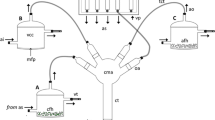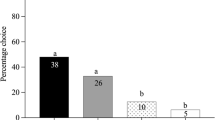Abstract
Gas chromatographic analysis revealed that chemicals attractive toCampoletis sonorensis (Cameron), previously identified in cotton, were not present in wheat germ diet-rearedHeliothis virescens (F.) larvae. Diet-reared larvae fed cotton obtained the chemicals from cotton, with the consequence of enhanced kairomonal activity of the larvae and their frass toC. sonorensis. Parasitoids, presented a choice between cotton, cotton plus hosts, hosts alone, and control in an olfactometer, responded non-randomly, with the greatest number of responses to cotton plus hosts, and three times as many responses to cotton alone as to larvae alone. The role of the plant in the parasitoid-host relationship is discussed.
Similar content being viewed by others
References
Altieri, M.A., Lewis, W.J., Nordlund, D.A., Gueldner, R.C., andTodd, J.W. 1981. Elucidation of a chemical interaction between plants andTrichogramma wasps in Georgia soybean fields.Prot. Ecol 3:259–263.
Arthur, A.P. 1981. Host acceptance by parasitoids, pp. 97–120,in D. A. Nordlund, R. L. Jones, and W. J. Lewis (eds.). Semiochemicals: Their Role in Pest Control. John Wiley & Sons, New York.
Brown, W.L., Jr. 1968. An hypothesis concerning the function of the metapleural glands in ants.Am. Nat. 102:188–191.
Brown, W.L., Jr., Eisner, T., andWhittaker, R.H. 1970. Allomonesand kairomones: Iran- specific chemical messengers.Bioscience 20:21–22.
Camors, F.B., Jr. andPayne, T.L. 1972. Response ofHeydenia unica (Hymenoptera: Ptero- malidae) toDendroctonus frontalis (Coleoptera: Scolytidae) pheromones and a host-tree terpene.Ann. Entomol. Soc. Am. 65:31–33.
Elzen, G.W., Williams, H.J., andVinson, S.B. 1983. Response by the parasitoidCampoletis sonorensis (Hymenoptera: Ichneumonidae) to chemicals (synomones) in plants: Implica- tions for host habitat location.Environ. Entomol. 12:1872–1876.
Elzen, G.W., Williams, H.J., andVinson, S.B. 1984. Isolation and identification of cotton synomones mediating searching behavior by parasitoidCampoletis sonorensis.J. Chem. Ecol. 10:1251–1264.
Guillot, F.S., andVinson, S.B. 1972. Sources of substances which elicit a behavioral response from the insect parasitoid,Campoletis perdistinctus.Nature 235:169–170.
Massey, F.J., Jr. 1951. The Kolmogorov-Smirnov test for goodness of fit.J. Am. Slat. Assoc. 46:68–78.
Nettles, W.C., Jr., 1979.Eucelatoria sp. females: Factors influencing response to cotton and okra plants.Environ. Entomol. 8:619–623.
Nettles, W.C., Jr. 1980. AdultEucelatoria sp.: Response to volatiles from cotton and okra plants and from leaves ofHeliothis virescens, Spodoptera eridania andEstigmene acrea.Environ. Entomol. 9:759–763.
Nordlund, D.A., andLewis, W.J. 1976. Terminology of chemical releasing stimuli in intra- specific and interspecific interactions.J. Chem. Ecol. 2:211–220.
Nordlund, D.A., andSauls, C.E. 1981. Kairomones and their use for the management of entomophagous insects. XI. Effect of host plants on kairomonal activity of frass ofHeliothis zea larvae for the parasitoidMicroplitis croceipes.J. Chem. Ecol. 7:1057–1061.
Read, D.P., Feeney, P.P., andRoot, R.B. 1970. Habitat selection by the aphid parasiteDiaeretiella rapae (Hymenoptera: Braconidae) and the hyperparasiteCharips brassicae (Hymenoptera: Cynipidae).Can. Entomol. 102:1567–1578.
Sauls, C.E., Nordlund, D.A., andLewis, W.J. 1979. Kairomones and their use for the management of entomophagous insects VIII. Effect of diet on the kairomonal activity of frass fromHeliothis zea(Boddie) larvae forMicroplitis croceipes (Cresson).J. Chem. Ecol. 5:363–369.
Vanderzandt, E.S., Richardson, C.D., andFort, S.W., Jr. 1962. Rearing of the bollworm on artificial diet.J. Econ. Entomol. 55:140.
Vet, L.E.M., Van Lenteren, J.C., Heymans, M., andMeelis, E. 1983. An airflow olfactometer for measuring olfactory responses of hymenopterous parasitoids and other small insects.Physiol. Entomol. 8:97–106.
Vinson, S.B. 1976. Host selection by insect parasitoids.Annu. Rev. Entomol. 21:109–133.
Vinson, S.B. 1981. Habitat location, pp. 51–77,in D.A. Nordlund, R.L. Jones, and W.J. Lewis (eds.). Semiochemicals: Their Role in Pest Control. John Wiley & Sons, New York.
Weseloh, R.M. 1981. Host location by parasitoids, pp. 97–100,in D.A. Nordlund, R.L. Jones, and W.J. Lewis (eds.). Semiochemicals: Their Role in Pest Control. John Wiley & Sons, New York.
Wilson, D.D., Ridgway, R.L., andVinson, S.B. 1974. Host acceptance and oviposition behavior of the parasitoidCampoletis sonorensis.Ann. Entomol. Soc. Am. 67:271–274.
Author information
Authors and Affiliations
Rights and permissions
About this article
Cite this article
Elzen, G.W., Williams, H.J. & Vinson, S.B. Role of diet in host selection ofHeliothis virescens by parasitoidCampoletis sonorensis (Hymenoptera: Ichneumonidae). J Chem Ecol 10, 1535–1541 (1984). https://doi.org/10.1007/BF00988422
Received:
Revised:
Issue Date:
DOI: https://doi.org/10.1007/BF00988422




